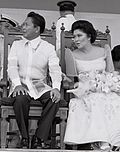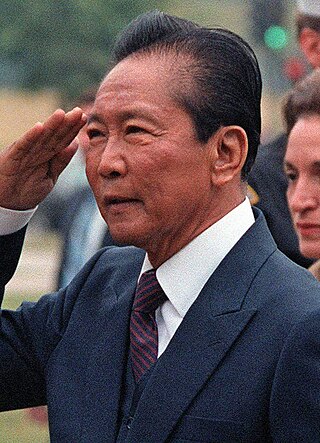
Ferdinand Emmanuel Edralin Marcos Sr. was a Filipino politician, lawyer, dictator, and kleptocrat who served as the tenth president of the Philippines from 1965 to 1986. He ruled under martial law from 1972 until 1981 and kept most of his martial law powers until he was deposed in 1986, branding his rule as "constitutional authoritarianism" under his Kilusang Bagong Lipunan. One of the most controversial leaders of the 20th century, Marcos' rule was infamous for its corruption, extravagance, and brutality.
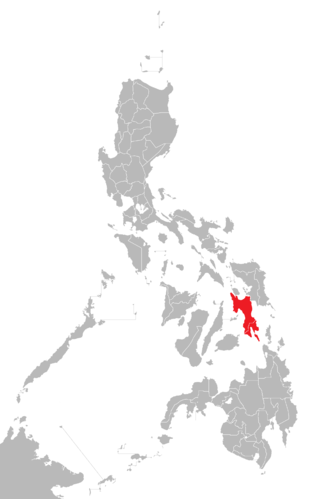
Leyte is an island in the Visayas group of islands in the Philippines. It is eighth-largest and sixth-most populous island in the Philippines, with a total population of 2,626,970 as of 2020 census.
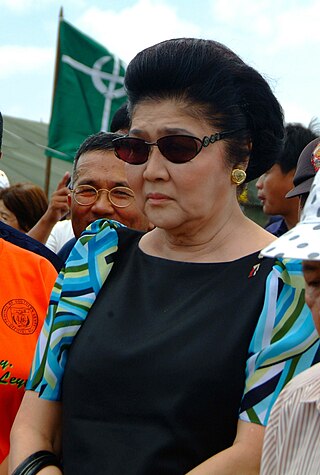
Imelda Romualdez Marcos is a Filipino politician and convicted kleptocrat who was First Lady of the Philippines from 1965 to 1986, wielding significant political power after her husband Ferdinand Marcos placed the country under martial law in September 1972. She is the mother of current president Bongbong Marcos.

San Juanico Strait is a narrow strait in the Eastern Visayan region in the Philippines. It separates the islands of Samar and Leyte and connects Carigara Bay with the San Pedro Bay. It is about 38 kilometres (24 mi) long. At its narrowest point, the strait is only 2 kilometers (1.2 mi) wide.

Tacloban, officially the City of Tacloban, is highly urbanized city in the Eastern Visayas region of the Philippines. The city is autonomous from the province of Leyte, although it serves as its provincial capital. According to the 2020 census, Tacloban has a population of 251,881, making it the most populous city in the Eastern Visayas. The city is located 360 miles (580 km) southeast from Manila.

Santa Rita, officially the Municipality of Santa Rita, is a 3rd class municipality in the province of Samar, Philippines. According to the 2020 census, it has a population of 42,384 people.

Silvino Lobos, officially the Municipality of Silvino Lobos, is a 4th class municipality in the province of Northern Samar, Philippines. According to the 2020 census, it has a population of 15,100 people.

Daniel Z. Romualdez Airport, also known as Tacloban City Airport, is a regional airport serving the general area of Tacloban, a highly urbanized city in the Leyte island of the Philippines. It is the main gateway from Manila and Cebu to Eastern Visayas. It is classified as a Class 1 principal airport by the Civil Aviation Authority of the Philippines. In 2022, Daniel Z. Romualdez Airport served 1.48 million passengers, making it the seventh-busiest in the country.

The Pan-Philippine Highway, also known as the Maharlika Highway, is a network of roads, expressways, bridges, and ferry services that connect the islands of Luzon, Samar, Leyte, and Mindanao in the Philippines, serving as the country's principal transport backbone. Measuring 3,379.73 kilometers (2,100.07 mi) long excluding sea routes not counted by highway milestones, it is the longest road in the Philippines that forms the country's north–south backbone component of National Route 1 (N1) of the Philippine highway network. The entire highway is designated as Asian Highway 26 (AH26) of the Asian Highway Network.

Buntun Bridge is a river bridge that stretches from Tuguegarao City to Solana in Cagayan and spans the Cagayan River, the largest river basin in the Philippines. It forms part of the Santiago–Tuguegarao Road, a major junction of the Pan-Philippine Highway. It was the longest bridge in the Philippines upon its opening in 1969, surpassed in 1973 by the San Juanico Bridge.
The term "edifice complex" was coined in the 1970s to describe Philippine First Lady Imelda Marcos' practice of using publicly funded construction projects as political and election propaganda.

The Leyte Provincial Capitol was the seat of government of the Philippine province of Leyte until 2019. The historic building situated in Tacloban also served as the temporary national capitol in 1944 to 1945 during the World War II era.
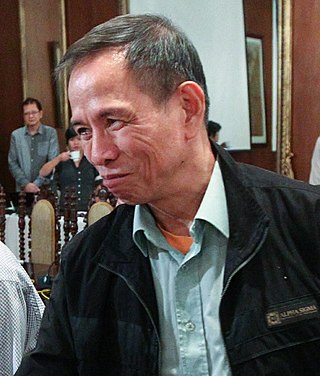
Benito Tiamzon was a Filipino political organizer and until his arrest in March 2014 by Philippine security forces, was believed to be the Chairman of the Communist Party of the Philippines (CPP) and its armed wing, the New People's Army (NPA).
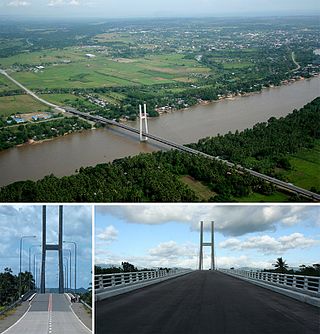
Macapagal Bridge is a steel cable-stayed bridge along Mayor Democrito D. Plaza II Avenue in Butuan, Agusan del Norte that crosses the Agusan River. It has a length of 908 m (2,979 ft), making it the longest bridge in Mindanao, and the third-longest cable-stayed bridge in the Philippines after the Marcelo Fernan Bridge and Cebu-Cordova Bridge.
Rodolfo Cuenca, sometimes known by his nickname, Rudy Cuenca, was a Filipino businessman best known as the chairman of the Construction and Development Corporation of the Philippines (CDCP), which is known today as the Philippine National Construction Corporation. He was a close associate of Ferdinand Marcos, and was noted not to be embarrassed by "his much-criticized close association with Marcos and his being tagged as a crony."
Certain associates of former Philippine President Ferdinand Marcos, historically referred to using the catchphrase "Marcos cronies", benefited from their friendship with Marcos – whether in terms of legal assistance, political favors, or facilitation of business monopolies, during his administration. Marcos critics, and the local and international press began referring to these individuals as "cronies" during the latter days of the Marcos dictatorship, and the Philippine government – especially the Presidential Commission on Good Government (PCGG) – continued using the term after the ouster of Marcos in 1986.

Local elections in Tacloban City, Leyte were held on May 13, 2019 within the Philippine general election. The voters elected candidates for the elective local posts in the city: the mayor, vice mayor, and ten councilors.

The COVID-19 pandemic in Eastern Visayas is part of the worldwide pandemic of coronavirus disease 2019 caused by severe acute respiratory syndrome coronavirus 2. The virus reached Eastern Visayas on March 23, 2020, when the first case of the disease was confirmed in Northern Samar.
The Build Better More (BBM) is the infrastructure program of the Marcos administration (2022–2028). It superseded the Build! Build! Build! infrastructure program of the Duterte administration (2016–2022). The following Infrastructure Flagship Projects (IFP)s were identified by the National Economic and Development Authority (NEDA).






















